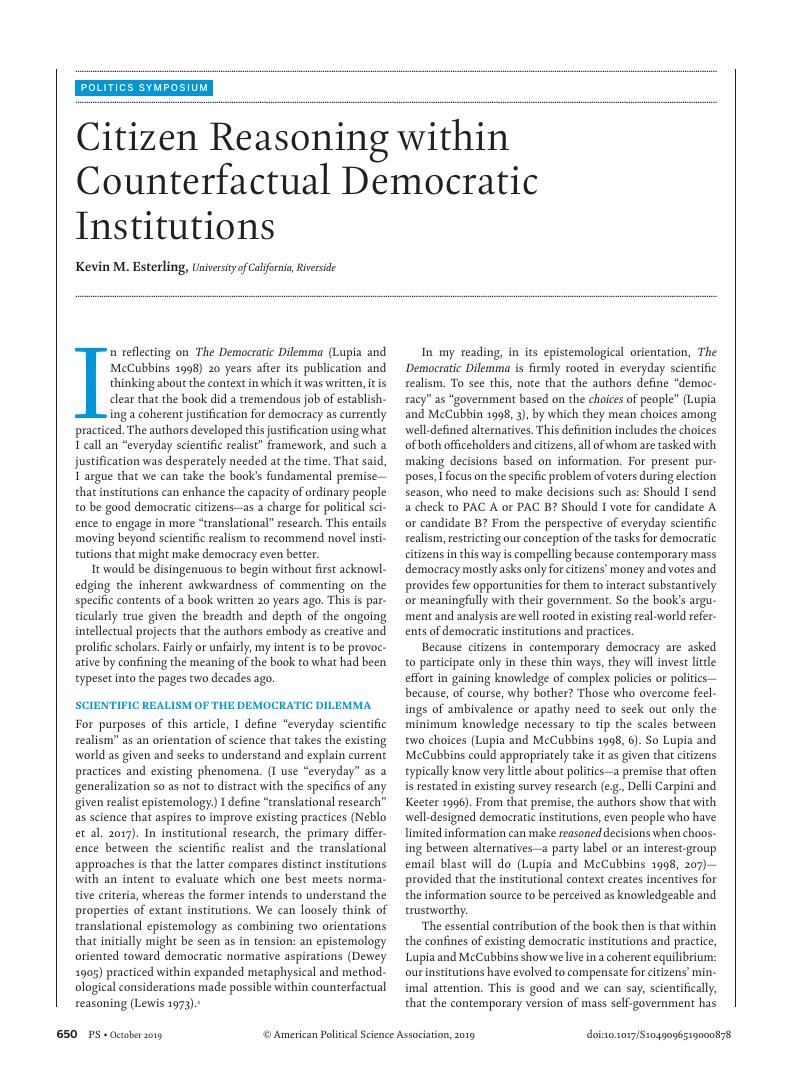No CrossRef data available.
Article contents
Citizen Reasoning within Counterfactual Democratic Institutions
Published online by Cambridge University Press: 08 July 2019
Abstract
An abstract is not available for this content so a preview has been provided. Please use the Get access link above for information on how to access this content.

- Type
- Symposium: Can Citizens Learn What They Need to Know? Reflections on The Democratic Dilemma
- Information
- Copyright
- Copyright © American Political Science Association 2019
References
REFERENCES
Broockman, David, and Kalla, Joshua. 2016. “Durably Reducing Transphobia: A Field Experiment on Door-to-Door Canvassing.” Science 352 (6282): 220–24.CrossRefGoogle ScholarPubMed
Cohen, Joshua. 1989. “Deliberation and Democratic Legitimacy.” In The Good Polity: Normative Analysis of the State, ed. Hamlin, Alan and Petit, Phillip, 67–92. New York: Blackwell.Google Scholar
Delli Carpini, Michael X., and Keeter, Scott. 1996. What Americans Know about Politics and Why It Matters. New Haven, CT: Yale University Press.Google Scholar
Dewey, John. 1905. “Philosophy and American National Life.” In Centennial Anniversary of the Graduation of the First Class, July Third to Seventh, 1904, 106–13. Burlington: University of Vermont.Google Scholar
Esterling, Kevin M., Neblo, Michael A., and Lazer, David M. J.. 2011. “Means, Motive, and Opportunity in Becoming Informed about Politics: A Deliberative Field Experiment Involving Members of Congress and Their Constituents.” Public Opinion Quarterly 75 (Fall): 483–503.CrossRefGoogle Scholar
Fishkin, James S. 2018. Democracy When the People Are Thinking: Revitalizing Our Politics Through Public Deliberation. New York: Oxford University Press.CrossRefGoogle Scholar
Gutmann, Amy, and Thompson, Dennis. 2004. Why Deliberative Democracy. Princeton, NJ: Princeton University Press.CrossRefGoogle Scholar
Hibbing, John R., and Theiss-Morse, Elizabeth. 2002. Stealth Democracy: Americans’ Beliefs about How Government Should Work. New York: Cambridge University Press.CrossRefGoogle Scholar
Lewis, David. 1973. “Counterfactuals and Comparative Possibility.” Journal of Philosophical Logic 2 (4): 418–46.CrossRefGoogle Scholar
Lupia, Arthur, and McCubbins, Mathew D.. 1998. The Democratic Dilemma: Can Citizens Learn What They Need to Know? Cambridge: Cambridge University Press.Google Scholar
Neblo, Michael A. 2015. Deliberative Democracy between Theory and Practice. New York: Cambridge University Press.CrossRefGoogle Scholar
Neblo, Michael A., Esterling, Kevin M., Kennedy, Ryan, Lazer, David, and Sokhey, Anand. 2010. “Who Wants to Deliberate—and Why?” American Political Science Review 104 (3): 566–83.CrossRefGoogle Scholar
Neblo, Michael A., Esterling, Kevin M., and Lazer, David M. J.. 2018. Politics with the People: Building a Directly Representative Democracy. New York: Cambridge University Press.CrossRefGoogle Scholar
Neblo, Michael A., Minozzi, William, Esterling, Kevin M., Green, Jon, Kingzette, Jonathon, and Lazer, David M. J.. 2017. “The Need for a Translational Science of Democracy.” Science 355 (6328): 914–15.CrossRefGoogle ScholarPubMed
Pearl, Judea. 2000. Causality: Models, Reasoning, and Inference. New York: Cambridge University Press.Google Scholar
Riker, William H. 1988. Liberals against Populism: A Confrontation between the Theory of Democracy and the Theory of Social Choice. Prospect Heights, IL: Waveland Press.Google Scholar
Sanders, Lynn M. 1997. “Against Deliberation.” Political Theory 25 (3): 347–76.CrossRefGoogle Scholar
Shepsle, Kenneth A., and Weingast, Barry R.. 1981. “Structure-Induced Equilibrium and Legislative Choice.” Public Choice 37: 503–19.CrossRefGoogle Scholar




